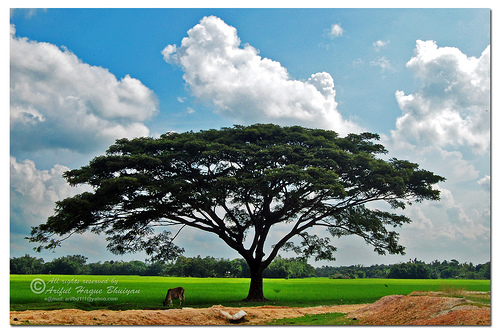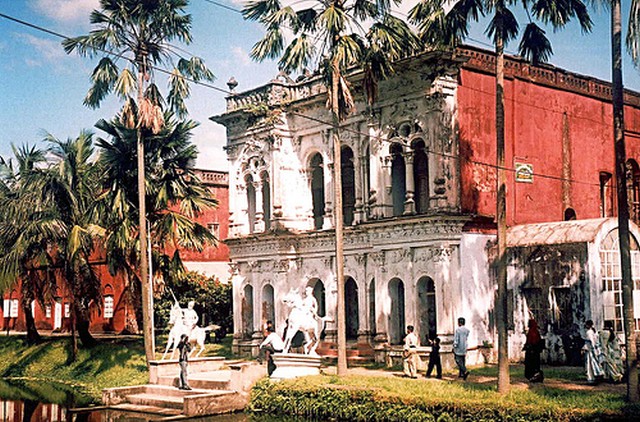There is a vibrant expatriate community in Bangladesh and many of them work as volunteers or are employed in numerous non-government organizations. Some of them are also blogging and are sharing their experiences and these are generally true and more authentic than what is reported by the international media about Bangladesh. These views are extremely useful for those who are coming to visit Bangladesh and for Bangladeshis too. In the first post of this series I will highlight some of these expat bloggers and what they are talking about.
Nikkibomb at Amar Bangla Na travels to the Chittagong Hill Tracts and writes:
The Chittagong Hill Tracts are unrelentingly green. Everywhere you look, it's that lush color that Bangladeshis love to wear.
Estelle Visagie was also in the Hill tracts in Rangamati where she found three lady Buddhist monks and was given a Chakma name.
Sara, who is studying and researching under a Fulbright scholarship posts plenty of pictures and her experiences of mingling with the Bangladeshis.

Nature in Bangladesh; Durgapur, Netrokona, By Ariful Haque Bhuiyan (http://www.flickr.com/photos/arifbd111/3401682813/), used under a Creative Commons license
Amy Moyer escaped from the frantic life of the capital and writes:
We ended the trip with a visit to the village where Jamdani cloth is hand woven. Jamdani is incredibly fine, light weight muslin that is a specialty of Bangladesh. Legend has it that a Jamdani sari, comprising approximately 13 yards of fabric, can be folded into the size of a matchbox. The people were so friendly and eager to let us try our hand at the weaving process. It was priceless and ironically they didn't take Visa.
Meandering Memos visits a handicrafts project in Narayanganj, near Dhaka where 26000 women are employed and writes:
Sari printing – I had no idea all the designs were all hand-stamped! What time-intensive work. The dyes they use are all from natural products.
Jacob and Sanna's blog praises the contemporary Bengali band ‘Bangla':
This band is different — they tastefully blend quality Western guitar & bass rhythms with a drum and folk tunes modified by their lead singer Anusheh's amazing voice.
Valerie at from Spa-Ha to Bangla is in the country for two months to visit her husband. She spends a day as a real house wife in the Bangladesh capital Dhaka and notices:
This was one of my cheapest days I’ve spent anywhere, ever. The total cost of spa treatments was 600 taka, less than $10. We generously overpay both driver and housekeeper to the point of being told we’re fools, and they earn $4.30 and $7 a day respectively. Tennis court time is $1/hour. Food costs are so minimal that it’s silly to even add up the cents.

Sonargaon, old capital of Bengal. Image by Flickr user Shubho Salateen (http://www.flickr.com/photos/shubho/242268273/) used under a creative commons license
Bernie Allen at Life and Work in Dhaka city visited Sonargaon, one of the oldest one time capitals of Bengal. She writes:
The Folklore Museum, that I was here to visit, houses artifacts from every cultural trait of the country, and its grounds are truly beautiful.
She was also out on the Buriganga River, which runs beside Dhaka. She finds that the river is threatened by pollution and “is only marginally less crowded and hectic than the busy city streets themselves!”
Heather at A Bangladesh Adventure posts some pictures of different vehicles in Dhaka city.
And last but not the least Caroline at Burkhas, Bibles and Bangladesh lists 20 things you may or may not have known about Bangladesh.







8 comments
Lovely post, Rezwan!
Thanks Rezwan. This is a good post with an interesting perspective.
This guy is a regular commentator on the BBC ~ he usually finds a way to blame America for everything. Even so this article is somewhat surprising coming from him. It does sound pro-Al-Qaeda rather than purely analytical. It talks about Al Qaeda’s strength in Iraq – and the government buildings they have managed to target – as an example of their power. But he leaves out how ridiculous Al Qaeda had become in Iraq – and why the Iraqis turned against them – for ex. they declared that fruit and vegetables should be divided up into male and female – and when women shopped they were only allowed to purchase the female kind – cucumbers for ex. had been deemed ‘male vegetables’ and so only men could buy these. And never mind sheer horror they put local people under to get them to see things their way.
On the occasion of the eighth anniversary of 9/11, ‘Abd Al-Bari ‘Atwan, editor of the pro-Al-Qaeda London daily Al-Quds Al-Arabi, wrote an editorial titled
“The Al-Qaeda Organization in Its 20th Year,”
in which he discussed the state of Al-Qaeda eight years after the launching of the war on terror. He wrote that “America’s stupidity and its failing wars” have turned Al-Qaeda, originally a regional organization, into a global power that is now stronger than it ever was before.
He added that this organization now has branches around the world that are possibly more powerful and dangerous than the parent organization itself. ‘Abd Al-Bari ‘Atwan also alluded to the fact that Al-Qaeda has not staged any large-scale operations in the West in recent years. This, he said, is simply due to the fact that Al-Qaeda now has access to hundreds of thousands of Western and American troops in Afghanistan and Iraq.
It should be noted that this article was also republished on jihadi websites.
Following are excerpts from the article:
“The War on Terror Has Failed”; Today Al-Qaeda Has New Branches, Perhaps Stronger and More Dangerous than the Parent Organization
“Opinions are divided on the state of Al-Qaeda and on the degree of danger it poses [today], eight years after the New York raid [of 9/11], which sparked the ‘war on terror,’ from the invasion of Afghanistan to the occupation of Iraq… But what is certain is that those who speak of the organization’s weakness are [merely expressing] the wishes of their heart, and are attempting to continue the obfuscation and deception that they have so successfully marketed on their TV programs and in their newspaper articles. The fact is that this organization is still alive and well, and is now celebrating its 20th anniversary − which proves that the war on terror has failed…
“Eight years ago, Al-Qaeda had only one address: the caves of Tora Bora in Afghanistan. Today it has several new branches, which are perhaps stronger and more dangerous than the [parent organization itself], such as Al-Qaeda in the Arabian Peninsula and [Al-Qaeda] in the Islamic Maghreb, as well as the organization’s branches in Iraq and on the Pakistan-Afghanistan border. [There is also] the branch in Somalia, which has been reestablished and is now stronger than it was before. Al-Qaeda has become like the many-headed dragon of mythology: whenever one head is chopped off, several [new] heads appear in its place.
Talking of Saris, check out Saris (Sarees) and (Cholis) Blouses at gayathris.com. They have an exquisite collection and a very snappy website. They have a stated mission of support the weaver community in India that need upliftment (just like the weavers in Bangladesh that you encountered). Take a look at the craftsmanship of this sari – Beatiful Samudrika Pattu Saree. Can you imagine such fine craftsmen being driven to suicide?